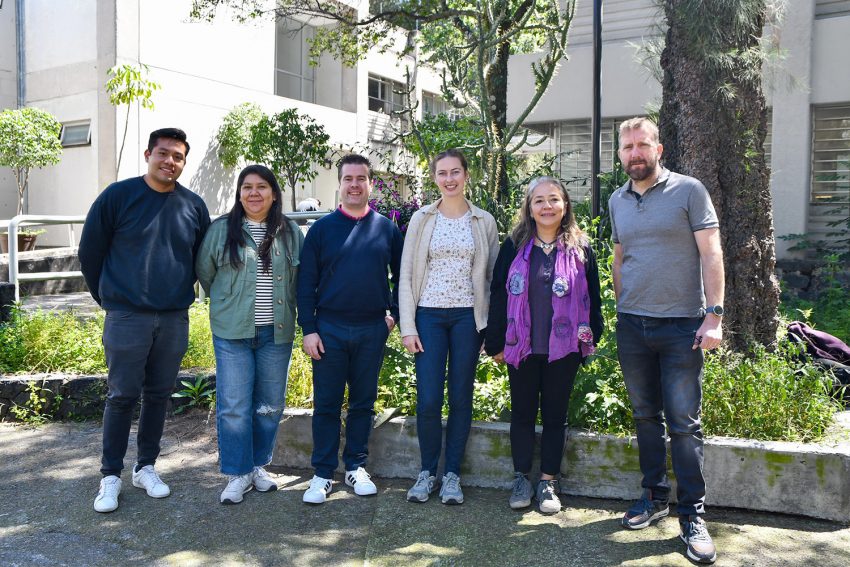Space physics between Mexico and Braunschweig, Mercury and Earth TU Braunschweig and Universidad Nacional Autónoma de México promote exchange
A partnership agreement between Technische Universität Braunschweig and the Universidad Nacional Autonóma de México (UNAM) in Mexico City was signed in March last year. As part of this partnership, Prof. Ferdinand Plaschke and Kristin Pump from the Institute of Geophysics and Extraterrestrial Physics (IGEP) visited the group of Prof. Xóchitl Blanco Cano from the Institute of Geophysics there. Together they explored possibilities for joint research into the space around the planets Earth and Mercury.

Group photo of the working groups from Braunschweig and Mexico (from left to right): Cristian Vaquero Bautista, Diana Rojas Castillo, Ferdinand Plaschke, Kristin Pump, Xóchitl Blanco Cano and Primož Kajdič. Photo credits: Ricardo Muñiz, UNAM
To facilitate exchanges between groups at both universities, a seed funding call was launched in May this year. Joint teams were able to submit project proposals between the end of May and mid-June. Successful project proposals were funded by UNAM and TU Braunschweig with a maximum of €10,000 (€5,000 per university). The funds will enable personal contacts between groups from both universities as a first step towards joint project proposals, e.g. within the framework of a UNAM-DFG funding opportunity. The funded project, entitled “Comparative study of dayside phenomena in solar wind interactions with planets (Earth and Mercury)”, will study disturbances in the solar wind directly in front of the planet Mercury and compare them with similar phenomena in the vicinity of Earth.
Planets in turbulent regions
All the planets in our solar system are exposed to the solar wind. This is a stream of electrically charged particles continuously emitted by the Sun. The particles are unable to penetrate directly into areas of significant planetary magnetic fields, the planets’ magnetospheres. Instead, the particles are slowed down and heated in so-called bow shock waves in front of the magnetospheres, and then deflected around the magnetospheres in an intermediate region called the magnetosheath. However, not all solar wind particles make it through the bow shock waves the first time. A small percentage of particles are reflected by the shock waves and rejoin the incoming solar wind along the interplanetary magnetic field. This leads to the formation of so-called foreshock regions, where the inflowing and reflected solar wind particles interact. These regions are the source of various waves and disturbances that modify the solar wind before it reaches the magnetospheres. These disturbances can have a significant impact on local space weather.
Foreshock phenomena on Mercury still largely unexplored
Disturbances in the foreshock region of Earth have been studied intensively over the past two decades, particularly using multi-satellite measurements. The CLUSTER mission of the European Space Agency (ESA) and the THEMIS and MMS missions of the US space agency NASA have been particularly important. However, such comprehensive measurements are still lacking for Mercury. So far, only NASA’s MESSENGER mission has been able to make long-term observations in Mercury’s vicinity. But help is on the way: ESA’s two-satellite BepiColombo mission is currently on its way to Mercury.
The Institute of Geophysics and Extraterrestrial Physics at TU Braunschweig is a major contributor to this mission, providing magnetic field measuring instruments called magnetometers. The mission will not arrive at Mercury until 2026. Until then, preparations for the mission’s main phase will continue, now also within the framework of the joint seed funding project.
Space physics from Mexico soon to be a guest in Braunschweig
The meeting at UNAM marked the start of the seed funding project. In addition to extensive scientific discussions and project planning, last week also saw seminars, workshops and outreach lectures in which Ferdinand Plaschke and Kristin Pump presented research results from Braunschweig as well as opportunities for exchange and cooperation under the new partnership agreement with UNAM. Both were received with the utmost hospitality and professionalism and are now looking forward to the return visit to TU Braunschweig in March 2025. By then, the first project results are expected to lead to joint publications and applications.
